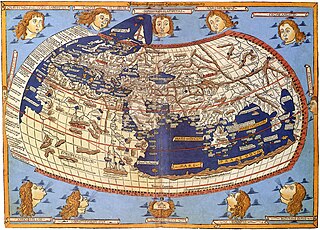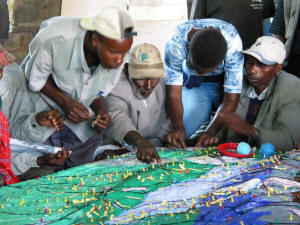
Cartography is the study and practice of making and using maps. Combining science, aesthetics and technique, cartography builds on the premise that reality can be modeled in ways that communicate spatial information effectively.

A geographic information system (GIS) consists of integrated computer hardware and software that store, manage, analyze, edit, output, and visualize geographic data. Much of this often happens within a spatial database; however, this is not essential to meet the definition of a GIS. In a broader sense, one may consider such a system also to include human users and support staff, procedures and workflows, the body of knowledge of relevant concepts and methods, and institutional organizations.

OpenStreetMap is an online map that uses an open geographic database, updated and maintained by a community of volunteers via open collaboration. Contributors collect data from surveys, trace from aerial photo imagery or satellite imagery, and import from other freely licensed geodata sources. OpenStreetMap is freely licensed under the Open Database License and is commonly used to make electronic maps, inform turn-by-turn navigation, and assist in humanitarian aid and data visualisation. OpenStreetMap uses its own topology to store geographical features which can then be exported into other GIS file formats. The OpenStreetMap website itself is an online map, geodata search engine, and editor.
Participatory GIS (PGIS) or public participation geographic information system (PPGIS) is a participatory approach to spatial planning and spatial information and communications management.

Web mapping or an online mapping is the process of using, creating, and distributing maps on the World Wide Web, usually through the use of Web geographic information systems. A web map or an online map is both served and consumed, thus, web mapping is more than just web cartography, it is a service where consumers may choose what the map will show.
Collaborative mapping, also known as citizen mapping, is the aggregation of Web mapping and user-generated content, from a group of individuals or entities, and can take several distinct forms. With the growth of technology for storing and sharing maps, collaborative maps have become competitors to commercial services, in the case of OpenStreetMap, or components of them, as in Google Map Maker, Waze and Yandex Map Editor.
México Indígena is a project of the American Geographical Society to organize teams of geographers to research the geography of indigenous populations in Mexico. The project's stated objective is to map "changes in the cultural landscape and conservation of natural resources" that result from large scale land privatization initiatives underway in Mexico. The project is led by Peter Herlihy at the University of Kansas and is funded by the U.S. Department of Defense through its Foreign Military Studies Office. The project has been the subject of criticism by various groups including groups representing indigenous peoples. Critics allege that the project was not forthcoming about its U.S. military funding, and that the project has various ulterior motives besides gathering information for research purposes. The project began in 2005, and lasted through 2008.
Traditional knowledge Geographic Information Systems (GIS) is a toolset of systems that uses data, techniques, and technologies designed to document and utilize local knowledge in communities around the world. Traditional knowledge is information that encompasses the experiences of a particular culture or society. Traditional knowledge GIS differ from ordinary cognitive maps in that they express environmental and spiritual relationships among real and conceptual entities. This toolset focuses on cultural preservation, land rights disputes, natural resource management, and economic development.
Critical cartography is a set of mapping practices and methods of analysis grounded in critical theory, specifically the thesis that maps reflect and perpetuate relations of power, typically in favor of a society's dominant group. Critical cartographers aim to reveal the “‘hidden agendas of cartography’ as tools of socio-spatial power”. While the term "critical cartography" often refers to a body of theoretical literature, critical cartographers also call for practical applications of critical cartographic theory, such as counter-mapping, participatory mapping, and neogeography.
Volunteered geographic information (VGI) is the harnessing of tools to create, assemble, and disseminate geographic data provided voluntarily by individuals. VGI is a special case of the larger phenomenon known as user-generated content, and allows people to have a more active role in activities such as urban planning and mapping.

Participatory 3D modelling (P3DM) is a community-based mapping method which integrates local spatial knowledge with data on elevation of the land and depth of the sea to produce stand-alone, scaled and geo-referenced relief models. Essentially based on local spatial knowledge, land use and cover, and other features are depicted by informants on the model by the use of pushpins (points), yarns (lines) and paints (polygons). On completion, a scaled and geo-referenced grid is applied to facilitate data extraction or importation. Data depicted on the model are extracted, digitised and plotted. On completion of the exercise the model remains with the community.

Neogeography is the use of geographical techniques and tools for personal and community activities or by a non-expert group of users. Application domains of neogeography are typically not formal or analytical.

Geographic information system (GIS) is a commonly used tool for environmental management, modelling and planning. As simply defined by Michael Goodchild, GIS is as "a computer system for handling geographic information in a digital form". In recent years it has played an integral role in participatory, collaborative and open data philosophies. Social and technological evolutions have elevated digital and environmental agendas to the forefront of public policy, the global media and the private sector.
Ancestral domain or ancestral lands are the lands, territories and resources of indigenous peoples, particularly in the Asia-Pacific region. The term differs from indigenous land rights, Aboriginal title or Native Title by directly indicating relationship to land based on ancestry, while domain indicates relationships beyond material lands and territories, including spiritual and cultural aspects that may not be acknowledged in land titles and legal doctrine about trading ownership.
Co-management, also known as community-based management, community-based resource management, cooperative management, joint management, and collaborative management, in the broadest terms refers to the administration of a particular place or resource being shared between multiple local and state management systems. Although co-management encompasses a spectrum of power-sharing arrangements, in the Canadian context it typically refers to agreements between government agencies and representatives of Indigenous peoples in Canada to jointly make land use and resource management decisions about a tract of government-controlled land or resource (e.g.fishery.).
Emanuela Casti is an Italian geographer and a cartography theorist. Considered an innovator, she has formalized a semiotic theory for the interpretation of maps in their various forms: from historical maps to cybercartography systems. She was full professor from 2001 to 2020 at the University of Bergamo (Italy) and is currently professor emeritus. In 2004 Casti founded the Diathesis Cartographic Lab, a permanent laboratory devoted to territorial analysis, cartographic innovation and experimentation and, in 2019, designed and activated the interclass master's degree, in Geourbanistica. Analisi e pianificazione territoriale, urbana, ambientale e valorizzazione del paesaggio at the University of Bergamo
Indigenous mapping is a practice where Indigenous communities own, control, access, and possess both the geographic information and mapping processes. It is based on Indigenous data sovereignty/intellectual property.

Internet GIS, or Internet geographic information system (GIS), is a term that refers to a broad set of technologies and applications that employ the Internet to access, analyze, visualize, and distribute spatial data. Internet GIS is an outgrowth of traditional GIS, and represents a shift from conducting GIS on an individual computer to working with remotely distributed data and functions. Two major issues in GIS are accessing and distributing spatial data and GIS outputs. Internet GIS helps to solve that problem by allowing users to access vast databases impossible to store on a single desktop computer, and by allowing rapid dissemination of both maps and raw data to others. These methods include both file sharing and email. This has enabled the general public to participate in map creation and make use of GIS technology.

Web GIS, or Web Geographic Information Systems, are GIS that employ the World Wide Web to facilitate the storage, visualization, analysis, and distribution of spatial information over the Internet. The World Wide Web, or the Web, is an information system that uses the internet to host, share, and distribute documents, images, and other data. Web GIS involves using the World Wide Web to facilitate GIS tasks traditionally done on a desktop computer, as well as enabling the sharing of maps and spatial data. While Web GIS and Internet GIS are sometimes used interchangeably, they are different concepts. Web GIS is a subset of Internet GIS, which is itself a subset of distributed GIS, which itself is a subset of broader Geographic information system. The most common application of Web GIS is Web mapping, so much so that the two terms are often used interchangeably in much the same way as Digital mapping and GIS. However, Web GIS and web mapping are distinct concepts, with web mapping not necessarily requiring a Web GIS.
Bioregional mapping is a participatory approach to cartography that focuses on mapping the natural, ecological, and cultural features of a bioregion—an area defined by its natural boundaries, such as watersheds, ecosystems, and cultures that arise form a place, rather than human borders. This method highlights the interconnectedness of the region's natural systems and human communities, offering a holistic view of the landscape that integrates ecological data with cultural and historical insights.








